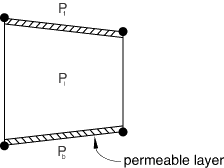Tangential Flow
The tangential flow within the cracked element surfaces can be modeled with either a Newtonian or power-law model. By default, there is no tangential flow of pore fluid within the cracked element surfaces. To allow tangential flow, define a gap flow property in conjunction with the pore fluid material definition.
In the case of a Newtonian fluid the volume flow rate density vector is given by the expression
where is the tangential permeability (the resistance to the fluid flow), is the pressure gradient along the cracked element surfaces, and is the opening of the cracked element surfaces.
Abaqus defines the tangential permeability, or the resistance to flow, according to Reynold's equation:
where is the fluid viscosity and is the opening of the cracked element surfaces. You can also specify an upper limit on the value of .
In the case of a power law fluid the constitutive relation is defined as
where is the shear stress, is the shear strain rate, is the fluid consistency, and is the power law coefficient. Abaqus defines the tangential volume flow rate density as
where is the opening of the cracked element surfaces.
By default, the gap between the cracked element surfaces has an initial opening of 0.002 in both a Newtonian fluid and a power law fluid. However, you can specify this opening directly.
Input File Usage
Use the following option to define the tangential flow in a Newtonian fluid:
GAP FLOW, TYPE=NEWTONIAN, KMAX
Use the following option to define the tangential flow in a power law fluid:
GAP FLOW, TYPE=POWER LAW
Use the following option to define the initial gap opening directly:
SECTION CONTROLS, INITIAL GAP OPENING
Abaqus/CAE Usage
Use the following option to define the tangential flow in a Newtonian fluid:
Property module: material editor: : Type: Newtonian: Toggle on Maximum Permeability and enter the value of
Use the following option to define the tangential flow in a power law fluid:
Property module: material editor: : Type: Power law
An initial gap opening is not supported in Abaqus/CAE.
